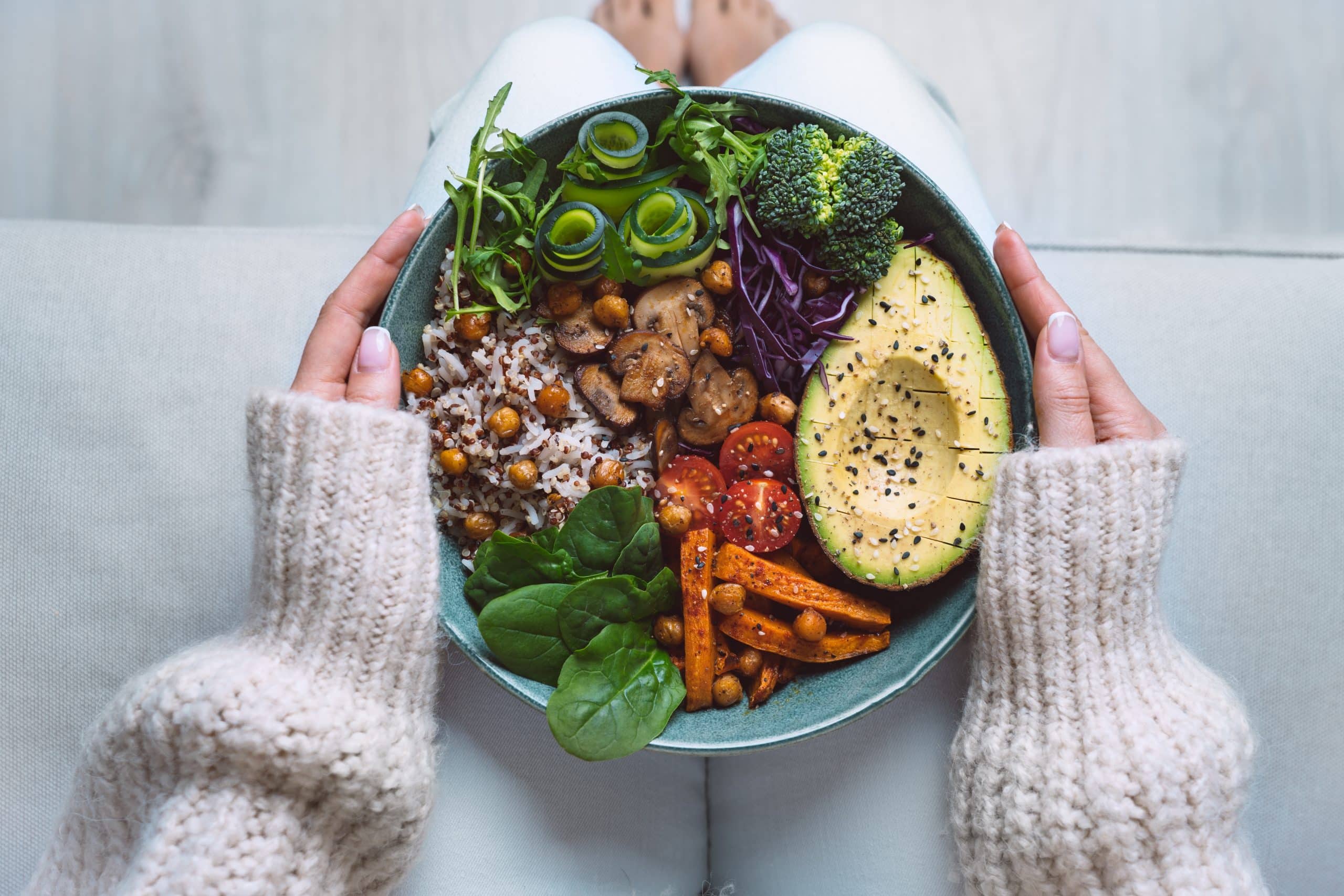The macro diet is a popular diet plan that is based on consuming a specific ratio of macronutrients (protein, fat, and carbohydrates) in order to lose weight (1). This diet is often praised for its flexibility as it doesn’t require counting calories and shifts dieters’ focus to food quality.
That being said, it can be confusing for beginners to determine which foods are best to eat and in what quantities. Should your macro diet be low-carb, high-fat, or high-protein? Does being female have any effect on what your ideal macro diet ratio should be?
In this article, we’ll take a look at the best macros for weight loss for women, according to the latest evidence. We will also provide some tips on how to make sure you’re getting enough of each nutrient and how to create a healthy and sustainable macro diet plan.
How Do I Calculate My Macros for Weight Loss?
The easiest way to calculate your macros is to use an online calculator or app. These will take into account your age, height, weight, activity level, and goals to give you a starting point for how many grams of each macronutrient you should be consuming per day (2).
What Should a Woman’s Macros Be?
There is no one-size-fits-all answer to this question as the ideal female macros for weight loss will vary depending on your individual goals and circumstances.
However, a common starting point for women who want to lose weight is a ratio of 40% carbs, 30% protein, and 30% fat. This is a moderately low-carb scenario. It’s slightly under the acceptable macronutrient distribution range (AMDR) set in the Dietary Guidelines for Americans for carbohydrates, which is 45-65% of total calories (3).
While the 40-30-30 ratio is a starting point, you may need to adjust your macros depending on your activity level, goals, and how your body responds to the diet. For example, if you find that you’re not losing weight or are feeling very hungry with this ratio, you may need to reduce your carbs and increase your protein or healthy fat intake.
On the other hand, if you’re an athlete or have a very active lifestyle, you may need to eat more carbs to fuel your workouts and recovery. The best way to find out what works for you is to experiment with different ratios and track your progress.
Being a woman doesn’t automatically mean that you need to eat a certain ratio of macros. However, women may have different energy requirements than men and may need to eat more or less of certain nutrients.
At the end of the day, weight loss comes down to one most important factor, regardless of gender—calories in vs. calories out. As long as you’re in a calorie deficit, you should lose weight (4).
The exception to this rule could be if you have a hormonal imbalance or some other underlying condition, which can make weight loss more difficult (5). If you think you may have a hormonal imbalance, it’s best to speak to a doctor or registered dietitian who can help you tailor your diet to your individual needs.
Read more: Foods to Cut Out to Lose Weight In a Sustainable Way
What Are the Best Macros for Weight Loss?
Macros are three key nutrients that are essential for human health in relatively large quantities—protein, fat, and carbohydrates. All three of these nutrients have different functions in the body and each one is important for weight loss.
Protein
Protein is essential for building muscle, which is key for burning calories and losing weight. Protein also helps keep you feeling full and satisfied after meals, which can help reduce cravings and overeating (6).
The recommended intake for protein for weight loss is at least 0.8 grams per kilogram of body weight, or approximately 55 grams per day for a 150-pound woman. If you’re active and/or do strength training exercises, you may need more (7).
Good sources of protein include:
- Lean meats
- Poultry
- Fish
- Eggs
- Dairy
- Beans, lentils, and other legumes, including soy products (such as tofu)
- Seeds and nuts
Carbohydrates
Carbs have gotten a bad rap in recent years, but they’re actually an important part of a healthy diet. Carbs are the body’s main source of energy and are necessary for fueling daily activities as well as workouts and recovery (8).
Low-carb diets can be effective for weight loss, but they aren’t necessary for everyone. If you are active or have a lot of muscle mass, you may need to eat more carbs to support your activity level.
The recommended minimum intake for carbohydrates for brain function is 130 grams per day (9), but your daily goal will likely be higher and depend on your activity levels.
Good sources of carbs include:
- Fruits
- Vegetables
- Whole grains
- Legumes
- Some dairy products
Fats
Fat is an important nutrient for satiety, hormone production, and cell health. Despite what you may have heard, eating fat does not make you fat—in fact, it’s essential for weight loss (10).
That being said, fats have more calories per gram than protein and carbs, so it’s important to be mindful of your intake. The recommended amount of fat is 20-35% of daily calories (10). Certain types of fats are healthier than others, especially for your heart (11).
Good sources of fat include:
- Avocados
- Olive oil and other vegetable oils
- Nuts
- Seeds
- Fatty fish.
Read more: 6 Fat-Burning Smoothie Recipes You Can Make at Home
How to Calculate My Macros for Weight Loss
In addition to using an online calculator, a simple way to figure out your macro ratios is:
Determine Your Calorie Needs
Calorie needs vary depending on age, activity level, muscle mass, and weight loss goals. A good starting point is the National Institutes of Health’s body weight planner (2).
Tally Your Macros
From there, you can adjust your calorie intake up or down depending on your weight loss goals. For example, if you want to lose weight, you may need to eat fewer calories.
If you have a lot of muscle mass or are very active, you may need to eat more calories. The best way to find out what works for you is to experiment with different ratios and track your progress.
Again, an online calculator may save you some time, but it’s not necessary to use one. You can also speak to a doctor or registered dietitian if you need help figuring out your specific needs.
Track Your Progress
Once you have your macros set, the next step is to track your progress. There are a few different ways to do this, but the most important thing is to be consistent.
You can use an online tracker (12), or you can simply write down everything you eat in a journal. The important thing is to track your intake of protein, fat, and carbs so you can make sure you hit your targets.
You should also weigh yourself regularly and take measurements to track your progress. This will help you see if you’re on track to reach your goals.
Simpler Approach to Macros for a Beginner
It can seem rather overwhelming and confusing to figure out your macros, especially if you’re new to the concept. If that’s the case, don’t worry – there’s a simpler approach that can still help you lose weight and improve your health.
First, focus on eating whole, minimally processed foods most of the time. This means filling your diet with fruits, vegetables, whole grains, lean proteins, and healthy fats.
You can still enjoy the occasional treat, but make sure the majority of your diet is made up of nutritious, whole foods.
Second, pay attention to your portion sizes. This doesn’t mean you need to count calories or macros, but it’s important to be aware of how much food you’re eating.
A good rule of thumb is to fill your plate half full with vegetables, a quarter lean protein, and a quarter healthy, complex carbs. This will help ensure that you’re getting the nutrients you need without overeating (13).
Not everyone can eyeball their portions perfectly, so the hand method is a helpful way to make sure you’re not overeating. Here’s how it works:
- 1 fist = 1 cup of fruit or vegetables
- 1 palm = 3-4 ounces of protein (about the size of a deck of cards)
- 1 cupped hand = 1 cup of grains or starchy vegetables
- 1 thumb = 1 tablespoon of oil or nut butter
If you’re still hungry after a meal, wait 20 minutes before going for seconds. This will give your body time to register that you’re full. You may also want to try eating more slowly without distractions to help you focus on your hunger cues.
Getting an extra portion of non-starchy vegetables is always a good idea if you’re trying to lose weight. They’re filling and low in calories, so they can help you reach your calorie goals without feeling deprived.
Explore the basics of calorie counting in our blog post, How To Measure for Weight Loss.
Are There Any Benefits to Counting Macros?
The common, age-old approach to dieting was to simply focus on eating less and exercising more. However, this approach is often ineffective and can lead to weight cycling (yo-yo dieting) (14). Counting macros is a more effective approach to dieting for some people as it has the following benefits:
Focus on Food Quality
Counting macros encourages you to focus on the quality of the foods you’re eating, rather than simply the quantity. This is because each macro has a different effect on your body and eating the right mix of macros can help optimize your health (15).
For example, if you’re trying to lose weight, you should focus on eating mostly lean proteins, healthy fats, and high-fiber carbs. These foods are more filling and they also help boost metabolism and promote weight loss.
Builds Healthy Habits
Counting macros can also help to build healthy eating habits as it requires you to be more mindful of the foods you consume. This can help break unhealthy patterns of eating and make it easier to stick to your diet in the long term.
In addition, counting macros can help you develop a better understanding of nutrition and how different foods affect your body. This knowledge can then be used to make healthier choices even when you’re not dieting.
Personalized Approach
Another benefit of counting macros is that it’s a very personalized approach to dieting. How much an individual should eat varies based on their age, activity level, weight, and goals (13). This means you can tailor your diet to your specific needs, rather than following a one-size-fits-all approach.
For example, if you’re trying to build muscle, you need to eat more protein than someone who is simply trying to lose weight. If you’re very active, you’ll need more carbs than someone who is sedentary.
This flexibility makes counting macros a much more sustainable approach to dieting as it can be customized to your specific needs.
When it comes to weight loss, progress is made by inches, not miles, so it’s much harder to track and a lot easier to give up. The BetterMe: Health Coaching app is your personal trainer, nutritionist, and support system all in one. Start using our app to stay on track and hold yourself accountable!
What Are the Downsides of Counting Macros?
While there are many benefits to counting macros, there are also some potential downsides to consider:
The Macro Maze
One of the biggest downsides to counting macros is that it can be quite confusing and overwhelming, particularly if you’re new to the process. You may get stuck trying to figure out the perfect balance of macros for your needs and end up feeling frustrated.
For example, a cup of plain, low-fat Greek yogurt packs 25 grams of protein, but it also has 8 grams of carbs and 1 gram of fat (16). So, depending on your goals, you may need to eat more or less of this food to hit your macro targets.
This can be confusing and make it difficult to know how much of each food you should be eating. It’s important to remember that there’s no perfect way to count macros and that you’ll likely need to experiment with different approaches before you find what works best for you.
You should also remember that your macro goals are just goals and you don’t need to hit them precisely every day. Close is close enough.
Can Lead to Unhealthy Eating Behaviors
Another downside of counting macros is it can lead to unhealthy eating behaviors such as orthorexia. Orthorexia is an obsession with healthy eating that can lead to restrictive and unhealthy dieting behaviors (17).
While counting macros is not necessarily an unhealthy behavior, it can become problematic if you start to fixate on hitting your macro targets to the point where it interferes with your quality of life.
If you’re struggling with orthorexia or any other eating disorder, it’s important to seek professional help.
Our blog Macros for Weight Loss explores the pros and cons of counting your macros in greater detail.
The 30-30-30 rule for weight loss isn’t a widely recognized or standardized concept in the health and fitness industry. It refers to a specific approach or plan that involves a combination of diet, exercise, and lifestyle changes. It involves (18): While this approach can contribute to weight loss when combined with other healthy habits, it’s important to note that there is no one-size-fits-all solution for weight loss. The best approach is to create a personalized plan that takes into account your individual needs, preferences, and goals. In addition, focusing on overall health rather than just weight loss can lead to more sustainable and long-term results (19). The 80-20 rule for fat loss typically refers to a balanced approach to dieting and lifestyle, where 80% of your efforts are focused on healthy eating and exercise, while 20% allows for flexibility and indulgence (20). This rule encourages sustainable habits by promoting moderation rather than strict dieting, which makes it easier to maintain in the long term. To effectively implement the 80-20 rule, it’s important to: Practicing the 80-20 rule can help prevent feelings of deprivation or restriction, which makes it easier to stick to healthy habits in the long run. However, it’s still important to listen to your body’s needs and adjust accordingly. If you feel you need more structure or stricter guidelines, this rule may not be the best fit for you. A healthy and sustainable rate of weight loss is approximately 1-2 pounds per week (21), which means losing 8 pounds in 30 days is a realistic goal. However, this may vary for each individual depending on factors such as starting weight, body composition, and overall health (22). It’s important to focus on making lifestyle changes rather than solely aiming for a specific number on the scale. This can lead to long-term success and improvements in overall health, rather than just short-term results. Furthermore, rapid weight loss is often not sustainable or healthy for the body and can lead to negative consequences such as muscle loss, nutrient deficiencies, and yo-yo dieting (23). Setting realistic goals and focusing on gradual progress is the key to a healthy weight loss journey. One large egg contains 6.3 grams of protein (24). To reach 30 grams of protein, you need approximately 5 large eggs. YOu should keep in mind that the exact protein content can vary slightly depending on the size of the egg. What does calorie tracking look like if your goal is to bulk up? Take a look at our previous article — Macros for Weight Loss and Muscle Gain.FAQs
What is the 30-30-30 rule for weight loss?
What is the 80-20 rule for fat loss?
What is a realistic amount of weight to lose in 30 days?
How many eggs equal 30 grams of protein?
If you wish to free yourself from all the extra pounds that have been weighing you down for way too long, start using the BetterMe: Health Coaching app and overhaul your entire life!
The Bottom Line?
Counting macros can be a helpful tool for managing your weight and eating healthy. There’s no one perfect way to count macros, so it’s important to experiment with different approaches to find what works best for you.
While there are some potential downsides to counting macros, they can be avoided by using a flexible and individualized approach. If you think counting macros may be helpful for you, speak to a registered dietitian nutritionist to get started.
DISCLAIMER:
This article is intended for general informational purposes only and does not serve to address individual circumstances. It is not a substitute for professional advice or help and should not be relied on for making any kind of decision-making. Any action taken as a direct or indirect result of the information in this article is entirely at your own risk and is your sole responsibility.
BetterMe, its content staff, and its medical advisors accept no responsibility for inaccuracies, errors, misstatements, inconsistencies, or omissions and specifically disclaim any liability, loss or risk, personal, professional or otherwise, which may be incurred as a consequence, directly or indirectly, of the use and/or application of any content.
You should always seek the advice of your physician or other qualified health provider with any questions you may have regarding a medical condition or your specific situation. Never disregard professional medical advice or delay seeking it because of BetterMe content. If you suspect or think you may have a medical emergency, call your doctor.
SOURCES:
- Dietary macronutrients and food consumption as determinants of long-term weight change in adult populations: a systematic literature review (2012, ncbi.nlm.nih.gov)
- Body Weight Planner (n,d, niddk.nih.gov)
- Dietary Guidelines for Americans (2020, dietary guidelines.gov)
- Optimal Diet Strategies for Weight Loss and Weight Loss Maintenance (2021, ncbi.nlm.nih.gov)
- Hormone Balance for Weight Loss: Fact or Fiction? (n.d, blog.nasm.org)
- The role of protein in weight loss and maintenance (2015, sciencedirect.com)
- Protein for Life: Review of Optimal Protein Intake, Sustainable Dietary Sources and the Effect on Appetite in Ageing Adults (2018, ncbi.nlm.nih.gov)
- CARBOHYDRATES THE MASTER FUEL (n,d., usada.org)
- Carbohydrates (2014, sciencedirect.com)
- The Functions of Fats in the Body (2015, eufic.org)
- Fats, oils and heart health (2023, heartfoundation.org.au)
- Online Weight Management Gets Personal (2016, newsinhealth.nih.gov)
- Food Portions: Choosing Just Enough for You (2021, niddk.nih.gov)
- Weight Cycling and Its Cardiometabolic Impact (2017, ncbi.nlm.nih.gov)
- Macronutrients: A Simple Guide to Macros (n,d,avitahealth.org)
- Yogurt, Greek, nonfat milk, plain (2022, dc.nal.usda.gov)
- Orthorexia Nervosa: An Obsession With Healthy Eating (2017, ncbi.nlm.nih.gov)
- What is the trending 30-30-30 diet method, and does it actually work? (2023, mcpress.mayoclinic.org)
- Weight loss – a healthy approach (2024, betterhealth.vic.gov.au)
- All About the 80-20 (or Weekend) Diet (2023, webmd.com)
- Steps for Losing Weight | Healthy Weight and Growth (2023, cdc.gov)
- Factors Affecting Weight & Health (2023, niddk.nih.gov)
- Risks Associated With Excessive Weight Loss (2024, ncbi.nlm.nih.gov)
- Egg, whole, raw, fresh (2019, fdc.nal.usda.gov)














